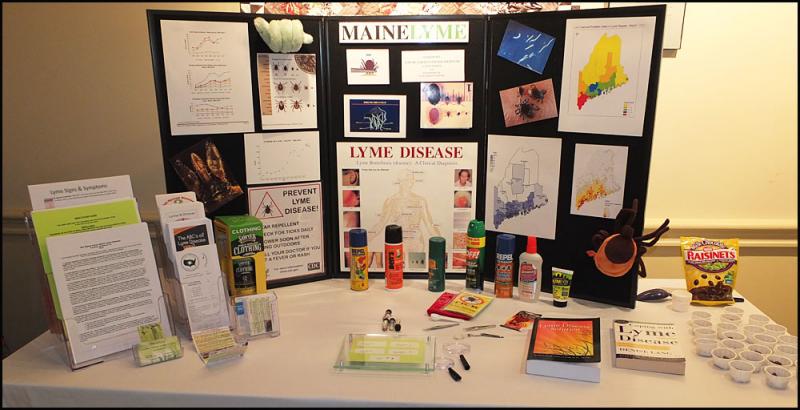Knox and Waldo counties considered tick central. Know the biology, don't get bit
CAMDEN — Listen up, because there will be a test at the end of this article. And get a bag of Raisenettes to munch while you read. Lyme disease specialist Dr. Bea Szantyr presented Tick Talk, an informative look at ticks, the bacteria Borrelia burgdorferi, which causes Lyme disease, the incidence of Lyme disease in Maine and steps you can take to protect yourself, family and pets. The talk was held recently at the Camden Public Library.
Definition: Any of numerous small bloodsucking parasitic arachnids of the family Ixodidae, many of which transmit febrile diseases, such as Rocky Mountain Spotted Fever and Lyme disease.
"There is no place in Maine that is at minimal or no risk of Lyme disease," said Szantyr. "It is either high risk, moderate risk, or low risk and the low risk is at the rooftop, northern part of the state."
Wet spring weather is just one factor that can help perpetuate the tick population.
Borrelia burgdorferi is the bacterium that causes Lyme disease. It's a Spirochete, also spelled spirochaete. You recognize the name from those health films we were all made to watch in seventh grade. Six different spirochetes have been identified, but it is believed that only Borrelia burgdorferi can cause Lyme disease. The first recorded case of Lyme disease was made in 1975 in Lyme, Connecticut. Cases of Lyme disease increase of course in summer months, but now they are cropping up in fall and even winter months.
Bottom line: There is no time of the year you are not safe from Lyme disease.
"Ticks acquire the infection from feeding on a rodent, usually a white-footed mouse specifically," said Szantyr. "It then transmits that infection to every other life stage. Know the difference between a deer tick and a wood, or dog tick. Size yes, but a dog tick or a wood tick has lacey white markings on their back; that's the best way to identify them. Deer ticks appear to be uniformly dark, or a two-tone appearance."
Now the bad news: Once a tick has attached itself to you and is engorged, it's hard to tell the difference between them. Not sure what an engorged tick looks like? Remember those Raisenettes we told you to munch while you read. Take a good look at one now and.. uh, huh... there you have it. Sorry if you lost your appetite for Raisenettes.
"As ticks crawl and look for their blood meal, they like to crawl up," said Szantyr. "If you're walking in grass that's ankle-high, where's the tick likely to be? If you're in grass and brush that's waist-high, where's the tick likely to be? This is important information to have because you can use the tick's biology to help protect yourself. If you tuck your shirt into your pants and your pants into your socks you've created a barrier from your feet to your wrists. Also wear light-colored clothes because ticks are dark and will show up better on light colored clothing."
Where do ticks like to hide? Many people think that ticks are only in the woods. Yes, they are found in the woods, but other places can be where fields and woods meet the lawn, tall brush or grass, under leaves, under ground cover in yards; i.e., plants, around stone walls and woodpiles where mice and other small animals live. Dr. Szantyr said if you have a swing set in your yard, put it out in the open sunlight away from shrubs, ground cover and wooded areas. It's also a good idea to have the ground beneath it be made up of sand or gravel.
Walmart Pharmacist Mary Curtis said it's not uncommon for people to come in with ticks on them. They want advice on how to remove them, or they have a prescription from a doctor for two 100 mg doses of doxycycline, which appears to be the treatment of choice for a tick bite if you're not sure if it carries Lyme disease.
The barbers at Eric's Barbershop in Camden said it was not uncommon to find a tick on someone's head while they're getting a haircut. Eric's does not remove ticks. The only thing they can do is stop cutting and send the person home to get it removed. They can come back in and finish getting their hair cut once it's gone.
And what do you do if you find a tick on yourself?
Dr. Szantyr said it's important to never annoy a tick. Covering it with petroleum jelly, or burning it with a match head, or using a cotton ball covered in soap, are all bad ideas. Why? It annoys the tick. The spirochete that carries Lyme disease lives in the tick's stomach. While it's taking in blood, its releasing saliva that acts as a anticoagulant. When you annoy a tick, it throws up, spilling its guts all over the bite site and it's a sure fire way to get infected with Lyme disease.
What's the proper method to remove a tick?
There are only two recommended methods to remove a tick: Tweezers and a tick removal tool. You should carry both in the glove box of your car and have a set at home. The type of tweezers you use to remove a tick is critical. Blunt tweezers are the type you use to pluck eyebrows. These tweezers are too broad and are more likely to squeeze the body of the tick. Fine-tipped tweezers (sometimes called precision tweezers) are fine enough to get close to the tick's mouth parts without coming into contact with the body, which avoids compressing it.
1) Grasp the tick as close to the skin as possible and pull upwards with steady, even pressure. Do not twist or jerk the tick as this may leave the mouth parts embedded.
2) Do not squeeze or crush the body of the tick, because its fluids (saliva and gut contents) may contain infective organisms.
3) Do not handle the tick with your bare hands because bacterium may enter through breaks in the skin or through mucous membranes (if you touch eyes, nostrils or mouth).
4) After removing the tick, disinfect the bite site with antiseptic and wash your hands with soap and hot water.
5) Save the tick for identification in case you become ill within several weeks. Write the date of the bite on a piece of paper and put it with the tick in a sealed plastic bag and store it in a freezer. Tweezers to freezer is the rule.
Tick Tools: There seems to be a lot of "tick tools" on the market and they all seem to do basically the same thing. It has a long handle and splays out at the bottom as it curves. This allows you to get it around the tick's head without disturbing the body. The instructions advise you to apply gentle pressure until the tick releases itself from your body. Do not force the tick out. The same holds true for tweezers. The tick does not automatically release when grasped. It's as strong willed as you are. And remember, don't annoy a tick. Just keep up with the gentle pressure until it releases. And just as with tweezers, put the tick in a plastic bag, date it, and put it in the freezer.
Disinfect the wound site and wash and disinfect the tool and your hands, or dispose of the tool.
Now what if you've had a tick and didn't realize it. Dr. Szantyr said that with 51 percent of tick bites a rash will appear. The "bull's eye" rash is the most common to identify. The rash has a spot in the middle of it where the tick bit, hence the name. If you develop the rash and come down with flu-like symptoms it's best to go see a doctor as quickly as you can.
Okay, we've covered the basics. It's now time to turn to science to try and tame the tick. There are two words you need to implant in your brain, "DEET," and "Permethrin." The first is supposed to repel ticks and the second is supposed to kill them. Since products with DEET are widespread and readily available we'll cover that one first.
DEET is a common chemical found in just about anything that says it will repel bugs and insects. Remember a tick neither flies nor is an insect. It's an arachnid (think spiders). And while these products might work to keep those pesky flying things away from you, they do very little to repel ticks, so don't bother to use them.
There have been numerous scientific studies done on DEET to grade its effectiveness as a tick repellant. Most of the studies have been carried out by the military and time and time again DEET scored low on the tick scale. An interesting side note did come out of the studies. DEET is a very effective fish repellant. A miniscule amount and we're talking parts per million here, will send fish running to the opposite end of a fish tank. Remember that next time you think about keeping a can of mosquito repellant in your tackle box, or spray yourself down when out on the lake and handle those bobbers and lures, think about that before you exclaim in French that the fish aren't biting. My dad used to always swear and then say "pardon my French." I think I was in the third grade and the teacher asked if anyone knew a foreign language. I raised my hand, but that's a different story.
Permethrin is a product that you spray on your clothes and not on your skin. It is 100 percent effective in killing ticks. It has a slight order when applied, but then it goes away when it dries. And it will stay in the fabric for a long time. No need to reapply it every couple of hours. It doesn't stain and won't melt synthetic fabric as DEET has been known to do. The following is taken from http://www.tickinfo.com/index.htm and explains it much better and more concisely then I can.
Permethrin Tick Tests:Test on ticks conducted in Massachusetts concluded that 100 percent protection was provided against the Deer tick (Ixodes Scapularis), which is the primary vector of Lyme disease in the Midwest and Northeast. The same outstanding results occurred when testing the Western Black Legged tick, Lone Star tick, American Dog tick and Brown Dog tick. Similar results have been found with other tick species throughout the United States and Europe. Two detergent washings did not diminish repellent killing action of permethrin-treated uniforms. In tests, ticks that crossed only 10 inches of treated fabric fell from the uniform, later dying due to this limited exposure.
So there you have it. And it only took you half a day to read the entire article. It was a lot of information and I really felt all of it was important for you to know.
Just in case you need some additional reading:
http://www.wikihow.com/Identify-a-Deer-Tick
http://npic.orst.edu/factsheets/PermGen.html
http://www.lymeneteurope.org/info/deet-versus-permethrin-as-a-tick-repellent
And now your test:
1. Deer ticks carry Lyme Disease T or F
2. Lacy white markings on their back distinguish Deer ticks T or F
3. Never annoy a tick T or F
4. Gently pull a tick straight out T or F
5. Keep wet leaves away from your house. T or F
6. Swing sets should be kept in a shady area. T or F
7. Fine tweezers or a tick removal tool are the best ways to remove a tick T or F
8. Ticks like to crawl up T or F
9. Tucking your pants into your socks and your shirt into your pants is an effective way to create a tick barrier T or F
10. Always wear dark colored clothing when walking among ticks T or F
Answers: 1 – T, 2 – F (Deer ticks are a solid color or two-tone), 3 – T, 4 – T, 5 – T, 6 – F (Swing sets should be in a sunny area away from woods and shrubs), 7 – T, 8 – T, 9 – T, 10 – F (Always wear light colored clothing, so the dark tick stands out against it).
Event Date
Address
United States













































